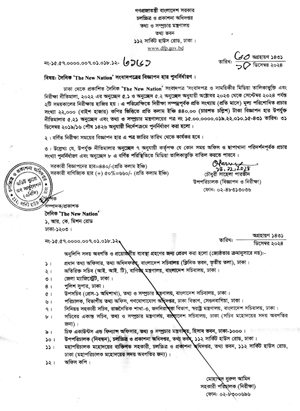Al Mamun Harun Ur Rashid :
Over 1.4 million farmers across 23 districts in the eastern region of Bangladesh have been severely impacted by recent floods, causing catastrophic damage to crops, particularly paddy fields, which are unlikely to recover this season.
According to the Department of Agriculture Extension (DAE), approximately 208,573 hectares of cropland have been inundated, leading to an estimated production loss of 714,514 metric tonnes. The financial toll of this disaster, amounting to 14.58 per cent, is estimated at Tk 3,346 crore.
The worst-hit districts include Cumilla, Noakhali, Feni, Laksmipur, Chattogram, and Brahmanbaria, where the impact on farming communities has been profound. The other affected districts include Narayanganj, Munshiganj, Narsingdi, Kishoreganj, Chandpur, Sylhet, Maulvibazar, Habiganj, Sunamganj, Cox’s Bazar, and Rangamati.
With the loss of paddy fields, a significant staple crop in the region, the economic and food security implications for these communities are expected to be dire.
Local authorities are working to assess the full extent of the damage and to provide relief to affected farmers, but the road to recovery remains long and uncertain.
A DAE officer stated that plans are in place to offer support to the affected farmers, including both financial to growing vegetables to compensate for their crop losses in the upcoming seasons,” said Dr Md Abu Zafur Al Munsur, Deputy Director (Monitoring) of the Field Service Wing at the DAE, in a recent interview with *The New Nation*.
He mentioned that each affected farmer in the impacted districts would receive 5 kg of seeds, 10 kg of DAP and MOP fertilisers, along with Tk 1,000 in cash. He added that by shifting to vegetable cultivation, farmers could expect a good harvest and favourable prices, helping them recover from their losses.
According to the DAE, out of a total of 1,414,089 farmers affected by the recent floods, 535,338 have experienced significant losses in transplanted Aman paddy, totalling 411,564 metric tonnes. This represents 15.27 per cent of the estimated production, with a financial loss of Tk 1,865.13 crore.
Additionally, 239,466 farmers have lost 106,426 metric tonnes of Aus paddy, accounting for 13.72 per cent of the estimated production, with financial losses estimated at Tk 509.57 crore.
The floods, which occurred from 16 August to 30 August, also damaged 14,908 hectares of T-Aman seedbeds, leading to an estimated loss of Tk 140.60 crore.
Beyond paddy damage, the floods have impacted various crops across 160,195 hectares. Specifically, 8,282 hectares of vegetables, 175 hectares of orchards (including banana trees), 116 hectares of turmeric, 74 hectares of ginger, 84 hectares of betel nuts, 53 hectares of sugarcane, and 23 hectares of watermelons have been affected.
Md Ekram Uddin, Deputy Director of Feni DAE, informed *The New Nation* that the recent floods had severely impacted his district, with 2,073 hectares of Aman seedbeds damaged out of the 2,042 hectares targeted for cultivation. Additionally, 31,145 hectares of Aman crops were lost out of the 32,486 hectares targeted, while Aus paddy losses totalled 1,854 hectares out of 20,648 hectares.
The floods also caused the total destruction of 525 hectares of autumn vegetables, while 7 hectares of ginger were lost out of 12 hectares, and 69 hectares of fruit crops were damaged out of 230 hectares.
“The floodwaters in Sonagazi and Dagonbhuiya remain stagnant at around 60 to 90 per cent, respectively. In other upazilas, farmers have begun producing winter vegetables, and we are providing them with the necessary support,” he said.
He also expressed concern about the potential intrusion of saline water, stating, “The rapid repair of embankments at Fulgachhi and Musapur point in Companyganj is urgently needed. If saline water enters the lands, it could cause permanent damage, posing a significant threat to crop production.”
The people of the eastern districts of Bangladesh have been struck by this unprecedented and devastating flood, unlike anything they have experienced before.
This sudden deluge has not only wreaked havoc on crops and livestock but has also tragically claimed the lives of over 50 people.
The flood’s impact has been especially harsh on the poor, many of whom have lost their homes and belongings, leaving them to grapple with immense hardship and uncertainty.
The interim government of Bangladesh has accused neighbouring India of releasing a massive volume of water without prior warning, exacerbating the severity of the flood.
According to officials, India abruptly opened its sluice gates, worsening the situation. The lack of communication and coordination has raised concerns, with many questioning the protocols in place for managing shared water resources between the two countries.
The disaster has underscored the region’s vulnerability to such natural calamities and highlighted the need for better cross-border water management and early warning systems to prevent future catastrophic events.
As the affected communities struggle to recover, the government faces mounting pressure to provide relief and rebuild the devastated areas while also addressing the broader issues of water management and disaster preparedness.
![Graph Outline 04-09-2024 [Converted] copy](https://dailynewnation.com/wp-content/uploads/2024/09/Graph-Outline-04-09-2024-Converted-copy.jpg)



